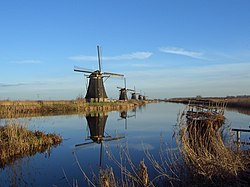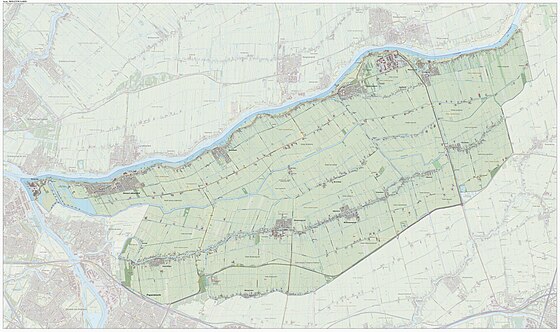Molenwaard
| Molenwaard | |||
|---|---|---|---|
| Municipality | |||

Kinderdijk wind mills
|
|||
|
|||
 Location in South Holland |
|||
| Coordinates: 51°52′N 4°47′E / 51.867°N 4.783°ECoordinates: 51°52′N 4°47′E / 51.867°N 4.783°E | |||
| Country | Netherlands | ||
| Province | South Holland | ||
| Established | 1 January 2013 | ||
| Government | |||
| • Body | Municipal council | ||
| • Mayor | Dirk van der Borg (CDA) | ||
| Area | |||
| • Total | 126.47 km2 (48.83 sq mi) | ||
| • Land | 118.29 km2 (45.67 sq mi) | ||
| • Water | 8.18 km2 (3.16 sq mi) | ||
| Elevation | −1 m (−3 ft) | ||
| Population (May 2014) | |||
| • Total | 28,986 | ||
| • Density | 245/km2 (630/sq mi) | ||
| Time zone | CET (UTC+1) | ||
| • Summer (DST) | CEST (UTC+2) | ||
| Postcode | 2957–2977 | ||
| Area code | 0184 | ||
| Website | www |
||
Molenwaard is a municipality in the western Netherlands, in the southeastern part of the province of South Holland, and the northwestern part of the region of Alblasserwaard. It has been the result of a merger of the municipalities of Graafstroom, Liesveld, and Nieuw-Lekkerland on 1 January 2013. Molenwaard has about 29,000 inhabitants and an area of about 126 km2 (49 sq mi). Biggest places are Bleskensgraaf, Groot-Ammers, and Nieuw-Lekkerland.
The municipality of Molenwaard lies about 1.5 m below sea level. It is bordered by the Lek river in the north and the Noord river in the west (just a small part). On its area flows the Graafstroom or Alblas river.
Molenwaard can be characterized as a landscape of polders existing of vast pastures traversed by ditches and canals, like the Groote- of Achterwaterschap, and the Ammersche Boezem. In the outermost northwest one can find the famous windmills of Kinderdijk.
From a churchly point of view the municipality belongs to the Bible Belt, with as outcome the dominating of the Christian parties in politics.
Molenwaard consists of the following settlements:
...
Wikipedia


